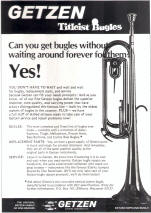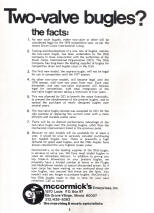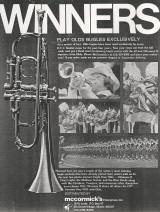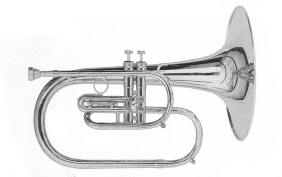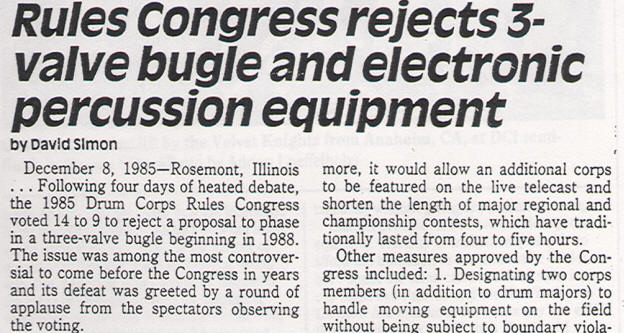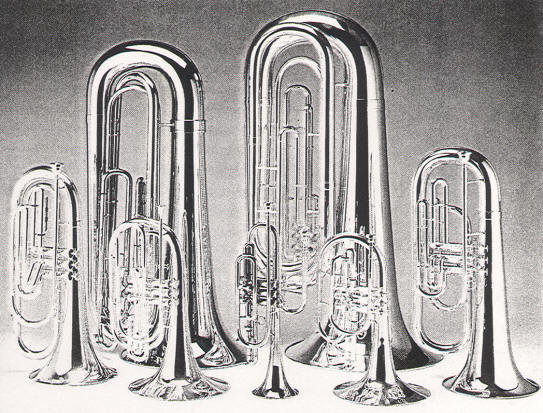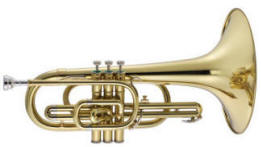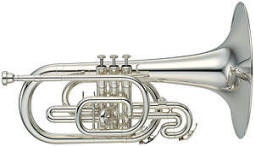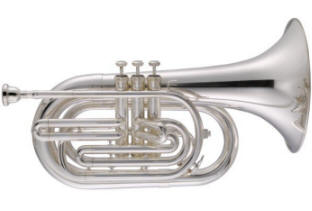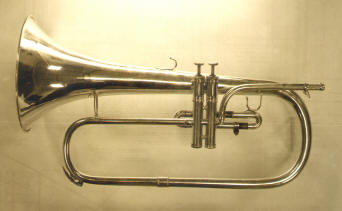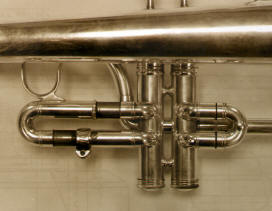
Home | Articles | Search | Enroll | Equipment | Mello Chest | Souvies | Links | Updates

Legalization of the G-F Bugle
The integration of secondary rotary pistons with multitudes of loop lengths complicated arrangements and adaptation for musicians to some degree. As a result, the environment seemed right for a bugle with a primary full-step piston loop. There were many obvious advantages for corps to utilize the "G-F" bugle although the governing bodies were at first unwilling to approve the change.
The American Legion and Veterans for Foreign Wars (VFW) maintained strict control over the competing drum corps during the late 1960s. However, these governing bodies were seldom staffed with knowledgeable musicians. Instead, those entrusted with the direction of drum corps often placed the activity with other duties such as dictating flag "codes" and "motorcycle field competitions."(82) Recognizable names in the drum corps realm including Jim Jones, Zigmant Kanstul, Larry McCormick, Don Warren, and many others expended great effort to convince the Legion of the importance of adopting the "G-F" piston.
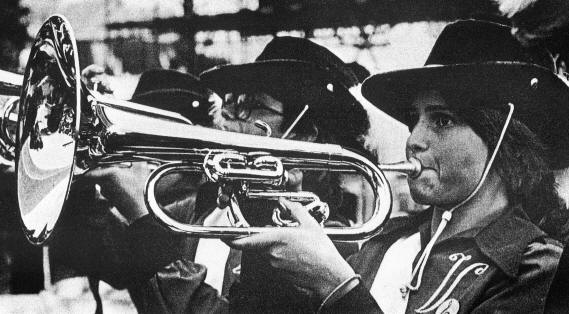 |
| This photograph from the late 1970s shows a G-F piston mellophone bugle (an F.E. Olds model) with a half-step rotor. Reprinted from Competitive Drum Corps: There and Then to Here and Now. |
Arguably the most drastic change to ever occur to drum corps was approved by the American Legion Supervisory Committee in October 1967. This rule, also adopted by the National Band and Drum Corps Committee of the VFW, permitted the "G-F" bugle to be used by competing corps beginning in 1968.
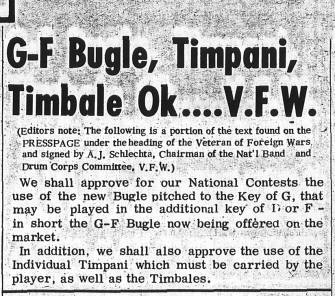 |
| VFW's approval of the G-F Bugle heralded the most significant change in the competition bugle since the 1930s. From the United States Canadian Drum Corps News, February 22, 1968. |
The "G-F" piston loop lowered the pitch by one whole step instead of four steps as with the "G-D" piston loop. Instrument maker Zigmant Kanstul has been credited for developing and manufacturing the first line of these "G-F" instruments for his corps, the Velvet Knights of Anaheim, California. The instruments produced by Olds for the Velvet Knights gained popularity and acceptance among other corps quite quickly. Production of these bugles began in February 1968.(83)
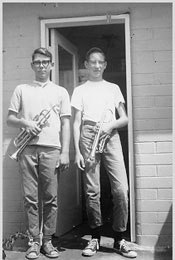 |
|
| Jack (left) and Zigmant Kanstul Jr. in 1964. Zig Sr.'s introduction of the "G-F" bugle in 1968 was the most significant advance in bugle evolution since the 1920s. From kanstul.com |
Beginning in 1968 the "G-F" bugle with a half-step rotor became the standard for drum corps. Now that the piston valve was a full step drop (as with the first valve of a standard trumpet) and the rotor most commonly used dropped the instrument's pitch a half-step (as does the second valve of a standard trumpet), the fingerings required for these instruments became identical to valved band instruments (except for the absence of a third valve).
During the transitional phase between "G-D" and "G-F" bugles, bugle manufacturers were producing both models simultaneously and having difficulty filling orders for the new "G-F" instruments. Advertisements by Getzen at the time offer advice and request purchasers to contemplate their decisions carefully prior to ordering--undoubtedly in the hopes of dissuading potential buyers from purchasing equipment from their competitor, F.E. Olds. Getzen's advertisement also included the patriotic statement echoed in bugle ads of decades prior: "To our knowledge, Getzen is the only 100% American Made Bugle."
Some confusion regarding the new "G-F" instruments swept through the ranks of the performers as corps began outfitting themselves with the new instruments. However, not everyone was confused. The venerable Pepe Notaro, French horn bugle soloist with the New York Skyliners approached his friend Tom Peashey of the Syracuse Brigadiers in hopes of borrowing his French horn bugle for the evening's competition. Peashey informed Notaro that he should take note that the instrument he was borrowing was a "G-F" bugle with fingerings different from the "G-D" instrument it was temporarily replacing. When asked by Peashey if he could handle the change, Notaro snapped back, "It's okay kid, I never use the [expletive deleted] valves anyway!"(84)
Kits were available from manufacturers of the "G-D" bugles that enabled corps to replace (and thereby shorten) the coil of tubing attached to their instrument's primary piston. Once again, shrewd manufacturing provided corps a cost effective alternative to upgrade their instrumentation without the necessity of purchasing entire new brass lines.
It was around this same time that new voices of bugles were being created corps such as the flugelhorn (championed by Ken Norman) that was first adopted by the Racine Kilties in 1969 and soon used by corps throughout the activity to expand their mid-voice sections.(85)
The Two-piston and Three-piston Bugle
Drum Corps International (DCI) was formed in 1971 and assumed the rulemaking responsibilities for the majority of competing junior drum corps. In 1975 a proposal was being prepared for consideration by DCI that would permit the use of two-piston bugles by DCI corps. The pistons incorporated into these bugles would both be actuated with fingers on the right hand (as with the trumpet).
As manufacturers set about the task of retooling and implementing changes in the design of the modern marching competition bugle, designers began to ask among themselves if it wouldn't be more prudent to go ahead and legalize the three-piston bugle. Even staunch drum corps purists, who detested legalization that would alter their beloved "G-F" instruments, were perplexed at the concept of legalizing instruments that offered no chromatic advantage over the piston rotor instruments they would replace.
Zigmant Kanstul let it be known that the Benge Company was prepared to create a sample set of three-piston instruments for consideration. Dave Peterson submitted drawing of three-piston instruments along with the two-piston prototypes by the Dynasty Bugle Corporation. Hoping to bypass the intermediate two-piston "phase," both designers envisioned small corps gaining acceptance (and assistance) from local band directors if drum corps instruments had more in common with bell front marching band instruments.(86)
Opponents of the three-piston instruments offered several counter arguments against their legalization. Retribution from angry musician's unions, legal action from BMI and ASCAP for music copyright infringements and financial inaccessibility for small corps were arguments used to shift the focus away from fully-chromatic bugles.(87) Fearing an amended proposal would fail, the Brass Caucus forged ahead with its recommendation for the two-piston bugle.
Many corps were ready to refurbish their bugle choirs by the mid-1970s. By 1976 approximately 8,000 bugles were being purchased annually in the United States, nearly twice as many sold in 1966.(88) Sensing the negative impact of corps stretching themselves financially, DCI structured their proposal to permit only the two-piston soprano for the 1977 season. Each year following, a new two-piston voice would be permitted for use by corps.
Proposal No. 1035 by Santa Clara Vanguard's director Gail Royer and the Madison Scout's director Bill Howard stated:
Each bugle shall be pitched in the key of G and may have two piston valves, or one piston and one rotary, or two rotary valves used freely to play in tow additional keys. Any other variation of these types of instruments and all other types of instruments are illegal.
No two piston soprano bugles may be utilized before the 1977 season. No two piston bass baritones may be utilized before the 1978 season. No two piston mellophones, French horns, flugles, or Contra Bass bugles may be utilized before the 1979 season.(89)
Disturbed by the possibility of a proposal for three-piston bugles arising in the near future, an interesting disclaimer was added to the proposal:
|
|
| Perhaps it was a Freudian slip, but Drum Corps News mentioned DCI permanent opposition to any three [valved] bugles in its November 26, 1975 issue. |
The Brass Caucus of DCI voted 63 for and 24 against the proposal legalizing the two-piston bugle. The subsequent proposal was adopted by DCI without modification.
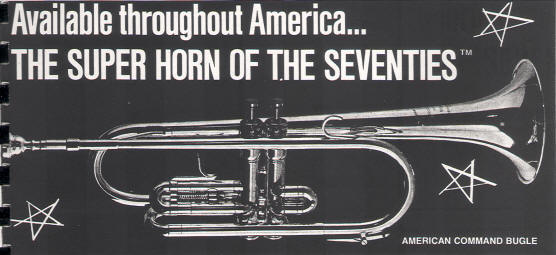 |
| The American Command Bugle was produced by Benge and later became the King line of bugles. |
The late 1970s were particularly hard on drum corps. The incremental financial burden to upgrade brass lines combined with soaring insurance costs, production expenses, mismanagement and population decrease among teenagers proved to be too much for many corps to bear. Between the 1978 and 1979 season, there was a startling 30% drop in the number of competing DCI junior corps.(90)
Despite the expense, a tremendous explosion of bugle designs occurred during the late 1970s and early 1980s. Instrument manufacturers retooled for the new two-piston instruments and stocked new types of voices (e.g., piccolo sopranos, alto bugles, tromboniums, flugabones, etc.). Further refinements also occurred to the existing mellophone and French horn bugles. D.E.G., King, and Getzen were the prominent instrument brands purchased by corps during this period.
|
|
|
|
The Dynasty II Herald Bugle from a mid-1980s catalog. |
|
|
|
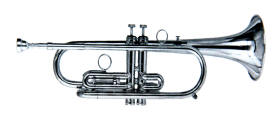 |
| The Dynasty II Piccolo Soprano Bugle from a mid-1980s catalog. | The Dynasty II Soprano Bugle from a mid-1980s catalog. |
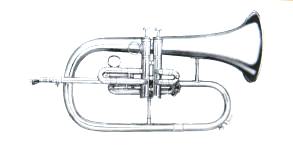 |
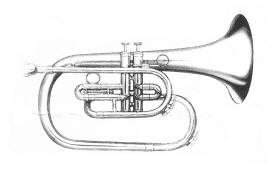 |
| The Dynasty II Flugelhorn Bugle from a mid-1980s catalog. | The Dynasty II Alto Bugle from a mid-1980s catalog. |
|
|
 |
| The Dynasty II Mellophone Bugle from a mid-1980s catalog. | The Dynasty II French Horn Bugle from a mid-1980s catalog. |
 |
|
| The Dynasty II Baritone Bugle from a mid-1980s catalog. | |
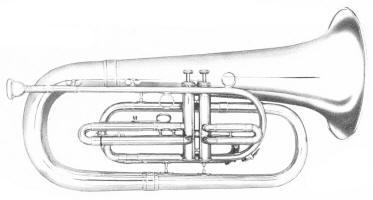 |
|
| The Dynasty II Euphonium Bugle from a mid-1980s catalog. | |
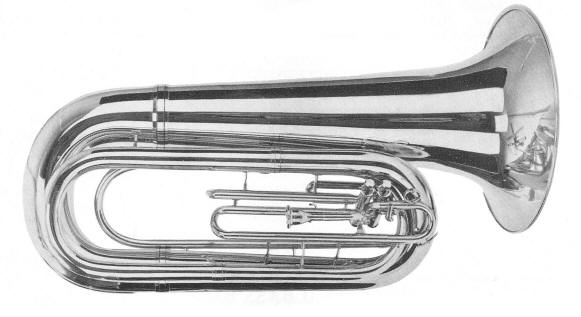 |
|
| The Dynasty II Contra Bass Bugle (Magnum Bore) from a mid-1980s catalog. | |
The increased variety of instruments offered brass arrangers an opportunity to augment the art of drum corps brass arranging. The late 1970s and early 1980s are considered a "renaissance" for drum corps brass sections. The typical "World Class" corps of the 1980s would likely have ten to twenty more horns than their counterparts of the 1960s. Consequently, a little more attention was also being placed on brass arrangements and performance techniques. Pioneers like Jim Ott, Larry Kerchner, Wayne Downey, Jim Wren, and Jim Prime, Jr. were able to tailor brass arrangements that exploited the strengths of the new instrument types now available to them.
Despite the apparent acceptance of the two-piston instruments, all was not well. Interest in the three-piston bugle began again in 1979. Manufacturers were appalled by the though of retooling their equipment to accommodate the manufacture of three-piston bugles before they had recouped the investments made to retool for the two-piston bugles. The flares, lead pipes, and most other components of the bugle would not differ after the introduction of the third piston, but retooling would have to occur to manufacture the redesigned valve clusters. Manufacturers of two piston bugles could expect to invest over $150,000 in order to accommodate three-piston bugle.(91)
Preferring to avoid the unstable climate of drum corps' governing body, King discontinued the manufacture of bugles during the 1980s. D.E.G. had already begun manufacturing its "Dynasty III" line of experimental three-piston bugles in 1977. By 1979, three-piston instruments were being shipped to Europe, where corps were permitted to compete with them.
Interest in the three-piston bugle eventually led to a proposal to allow their use in DCI competitions. The initial proposal for a three-piston bugle was soundly defeated (with applause from several in attendance) at the DCI rules congress held in December 1985. Initially aligned with a proposal to allow electronic instrumentation, the three-piston bugle issue soon separated itself from electronics and slowly gained broader-based acceptance among corps directors. The legalization of the three-piston bugle was voted on again in December 1987 and was approved by the Brass Caucus, but defeated by the corps directors.(92)
|
|
|
A December issue of Drum Corps World heralded the defeat of the vote to legalize the three-piston bugle and noted the enthusiasm that was expressed by many in attendance. |
Due to the DCI Rules Congress occurring every other year, the process of voting on the three-piston bugle proposal bi-yearly placed many drum corps and competition bugle manufacturers in a unique predicament. DCI corps ready to upgrade their instruments had to decide whether or not to purchase new two-piston instruments are wait for a decision to be made on the legalization of the three-piston bugle. Purchases would need to be made in the early fall if there were any hopes of having the instruments delivered in time for winter rehearsals. Voting on the proposal wouldn't occur until January. This set of circumstances proved costly to the manufacturers as corps indefinitely postponed bugle purchases for fear of newly purchased instruments becoming instantly obsolete.(93)
|
|
|
A full compliment of Dynasty III three-piston G bugles. From a Dynasty Product Catalog circa 1993. |
After careful crafting and intensive lobbying, a vote again occurred in January 1990. DCI's announcement of the legalization of the three-piston bugle was met with applause not unlike that experienced at the motion's initial defeat in 1985.
Similar to provisions in the rules change legalizing the two-piston bugle, the proposal ratified for the three-piston bugle required corps to gradually upgrade instruments over a three-year period. This concept permitted financially disadvantaged corps to "stay competitive" with corps that could have purchased all new instruments immediately.
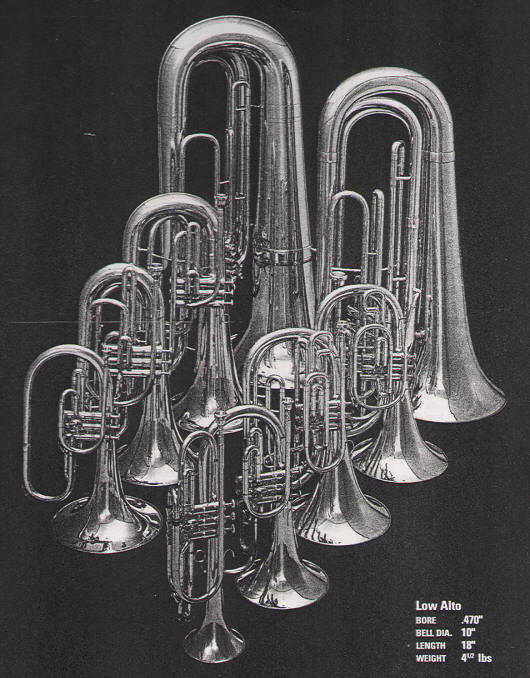 |
|
The entire family of Kanstaul three-piston G bugles, including an interesting low alto bugle (third from right). From a Kanstul catalog circa 1995. |
Unlike previous rules changes, two-piston and three-piston bugles could survive together in the same hornline. Many corps cautiously transitioned to three-piston instruments, clinging to the free-blowing two-piston instruments.
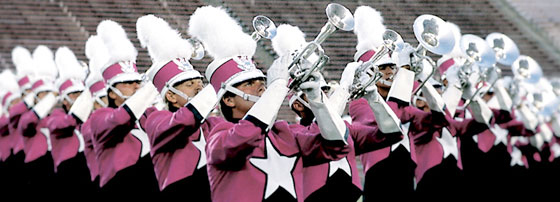 |
| Star of Indiana (image from 1986 season) utilized the same line of King two-piston bugles for its entire tenure as a drum and bugle corps, becoming the last corps to complete in Division I finals utilizing two-piston wind instruments exclusively. Reprinted from staralumni.org. |
Star of Indiana used the same line of unmodified King bugles it purchased in the fall of 1984 throughout its tenure as a competitive drum corps (except for 1985 when soprano player Larry Powell utilized his personal Dynasty II Soprano bugle). King Euphoniums were added to the Star horn line in the fall of 1985 and additional contrabasses were temporarily added in 1986, but otherwise the horn line remained virtually unchanged. Instructors believed performers who were given the opportunity to spend several years on one set of bugles could learn to compensate for the problems presented by the instruments. Ironically, the corps that prided itself as "State of the Art" was the very last corps in history to win a Division I Championship (or even compete in Division I Finals) using two-piston wind instrumentation exclusively.
The Competition Bugle's Influence on Marching Brasswinds
Due to the efforts of bugle manufacturers during the 1960s, 70s, and 80s, instruments used by marching bands began to look similar to marching bugles. Often, manufacturers would utilize drum corps as a "testing ground" for new types of instrument designs. Once these designs were created and successfully used by drum corps, they would often be applied to bell-front marching instruments used by marching bands.
|
|
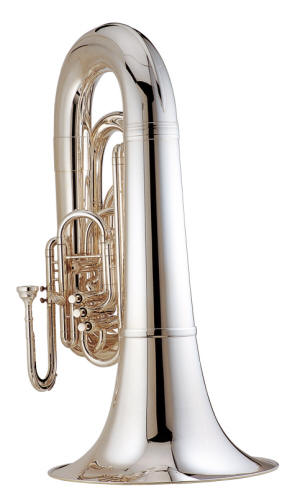 |
|
The F.E. Olds A-42 Compact Marching Mellophone (in "F") was first offered by the company in the early 1970s and most likely was directly impacted by the F.E. Olds Mellophone Bugle design. |
|
|
|
|
|
The Yamaha YMP-204 is currently a very popular marching "F" mellophone that takes many design cues from the F.E. Olds Design (above). |
The King Marching Tuba ("BB-flat") was strongly influenced by the King K-90 "G" Contrabass Bugles. |
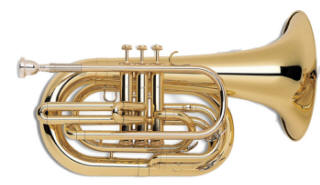 |
|
| The Bach Marching Baritone (current model number is 1160) is a design influence originating during the 1970s. | The F.E. Olds N-A30 Marching Baritone was created in the 1970s. |
How the marching mellophone supplanted the mellophonium may provide some interesting insights into this phenomenon. It is generally believed F.E. Olds was one of the first North American firms to widely distribute a compact marching bell-front mellophone designed, first delivering the instrument in the early 1970s.(94) Itís very likely the Zigmant Kanstul designed Olds G-F valve-rotor was the genesis of the F.E. Olds compact marching mellophone that became widely utilized mellophone design in North America in the 1980s. In essence, the compact "F" Mellophone was an Olds G-F valve-rotor mellophone with a cornet valve cluster replacing the valve-rotor assembly.
 |
|
How the compact marching "F" mellophone design permeated through several manufacturers during the 1980s offers some insight into the volatility of the instrument manufacturing realm during the late 1970s. F.E. Olds discontinued its manufacturing operations in 1979, presumably due to lack of sales. At the time, the compact "F" mellophone was badged as an F.E. Olds and as a "Reynolds" brand (model ML-13 in the Reynolds' 1973 price list).
The F.E. Olds production equipment was auctioned in November 1979 and the marching brass and large horn tooling equipment was purchased by Selmer-Bach in Indiana.(94) Selmer-Bach incorporated the compact marching mellophone design for its Bach and Mercedes line of marching mellophones that have virtually remained unchanged as of 2007. Yamaha, in turn utilized the design as its foundation for its marching mellophone that continues to grow in popularity.
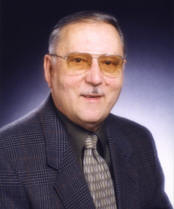 |
|
| Zigmant Kanstul |
Incidentally, Allied Music Supply purchased the unassembled instrument components from F.E. Olds at the November 1979 auction in Fullerton, California. Allied was one of the fabricators for D.E.G. and their Dynasty II and Dynasty III line of competition bugles. It would seem likely some of the Olds components found themselves installed in Dynasty bugles during the early 1980s.(95)
Zigmant Kanstul's transition from Olds to King Musical Instruments in 1970 to serve as a VP and manage the Benge Plant also eventually led to the creation of King line of bugles and "B-flat" and "F" marching bell-front brass instruments that continue to be widely used presently.
So, it seems unlikely that nearly all production marching mellophones being created presently are exempt from some influence from a production facility in California, and a designer named Ziggy.
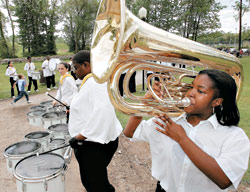 |
||
| Early models of the over-the-shoulder marching tubas positioned the horn on the player's right shoulder, opposed to the left shoulder of the "G" contrabass bugles. |
In addition to mid-voice instrumentation, low brass instruments used by marching bands also began to emulate designs used by drum corps. For example, bell-front marching "B-flat" baritones began to emulate their "G" baritone bugle counterparts. The sousaphone was also challenged in popularity during the 1980s by "over-the-shoulder" tubas that resembled their contrabass bugle counterparts (except for being position on the opposite shoulder than the "G" bugles).
During the mid-1990s, several division I drum and bugle corps utilized reconfigured band instruments in their hornlines, including the contrabass bugle section of the Cadets of Bergen County and the flugelhorn section of the Concord Blue Devils.
Drum Corps Evolving Mid-Voice
Prior to 1964, drum corps had no need for the term "mid-voice" because the section that occupied the space between the soprano and baritone section was simply referred to as the "French horn section." However, the introduction of the mellophone bugle changed how mid-voices were configured.
The mellophone bugle is pitched in the same octave as the soprano bugle. This permitted some of the melodic duty formerly dominated by the soprano to be shared with the mellophone bugle section.
By 1969, flugelhorn bugles would be added to existing drum corps mid-voices (also pitched in the same octave as the soprano and mellophone), championed by Kenny Norman and the Kilties Drum and Bugle Corps of Racine, Wisconsin.
Alto bugles were also added to the mix in the 1970s. Alto bugles often took the form of a mellophone bugle, but with a smaller bell and a much less dramatic bell flare. Some manufacturers utilized trumpet-sized mouthpieces for these instruments. However, larger mouthpieces that were close to traditional alto horn mouthpieces were also occasionally paired with these instruments by either the manufacturer or the performer.
By the 1970s many drum corps mid-voice sections that once contained French horns or mellophones became the home to mellophones, French horns, alto bugles and flugelhorns. There was a great deal of variety in the manner in which these instruments were used by their corps. Some brass arrangers choose to pair parts of their mid-voice with other brass sections. For instance, French horn bugles would be paired with the lead baritone section and flugelhorns would sometimes double lower soprano parts. However, some arrangers chose to configure the mid-voice section to serve as a brass choir within a choir. Robert Smith's brass arrangements utilized by Florida's Suncoast Sound demonstrate how the mid-voice section could be used to greatly enhance the richness and density of complex musical arrangements (click here for link to mp3 file).
Some corp's mid-voices would use the French horn as their foundation, flugelhorns and alto bugles as ancillary mid-voice instruments, and the mellophone as the descant voice. Despite numerous intonation problems associated with such diverse instrumentation being utilized in such an acoustically compacted environment, many great corps brass sections were made even better through the effective deployment of their mid-voice.
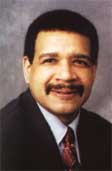 |
|
| James Prime, Jr. |
By the early 1980s music arranger Jim Prime, Jr. and brass caption head Donnie Van Doren had streamlined the mid-voice section of the Garfield Cadets by utilizing mellophones exclusively. This "less is more" concept had been championed by Larry Kerchner with the Blue Rock corps of the late 1960s, but wasn't widely emulated until the mid 1980s. Instead of evolving the instrument, the use of one instrument type for the mid-voice was an evolution in how the instruments were utilized by the drum and bugle corps activity. A larger group (12 or more) of identical instruments (mellophone bugles) divided into two sections provided many advantages for some corps. Intonation problems were narrowed and better managed with fewer instrument types. By the late 1980s, most corps had eliminated the French horn and flugelhorn bugles completely, opting instead for mellophone bugles.
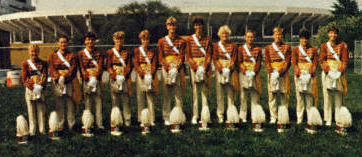 |
| The 1984 Garfield Cadet mellophone section is an example of the change in the use of the section by arrangers during the 1980s. |
Other experimentation prompted by necessity was undertaken by the Concord Blue Devils in 1987. Brass staff members of the California-based corps were unsatisfied with their current mid-voice instrumentation. Jack Meehan and Wayne Downey contracted Zigmant Kanstul to create a new instrument for its mid-voice section. Named the "Meehaphone" in honor of Jack Meehan, the instrument was literally a two piston descant horn designed in a flugelhorn style (valve cluster left of the flare and the blowpipe entering the valve cluster's first piston). Equipped with custom mouthpieces by Terry Warburton, Meehaphones were standard issue to mid-voice performers from 1987 through 1991. Eventually, the section was augmented with mellophones and then supplanted by custom reconverted Yamaha flugelhorns.
|
|
|
A Kanstul Meehaphone, s/n 1036 utilized by the Concord Blue Devils from 1987 through 1991. This instrument was outfitted with a custom Terry Warburton mouthpiece (similar to a flugelhorn cup). |
Interchangeable Instrumentation
Experimentation with bugles by North American drum corps offered many unique variations and improvements that gave their ensembles a competitive edge. Alterations occurred to improve the instrument's playing characteristics and intonation. Sometimes bugles would be altered so that they would be pitched in keys other than "G," or bugles would be outfitted with valves or other devices to enable the instruments to access as many notes as possible. Such variations were strictly forbidden by competition rules, but since there were few influential corps "without sin," very few stones were cast by the governing bodies of drum corps. It was in this spirit that experimentation in "convertible instruments" took place during the late 1980s and the early 1990s.
Contrabass bugles derived from "B-flat" recording tubas derived from "B-flat" recording tubas were first used by the Crossmen Drum and Bugles Corps in 1987. Mike Dennis "created" a "G" contrabass by performing some minor alterations to a stock recording tuba. This was accomplished by reconfiguring the lead pipe (to permit "over-the-shoulder" usage) and adding additional tubing to drop the instrument's pitch from "B-flat" to "G." After the third piston was "blanked off," the instrument was ready for the field. The legalization of the three-piston bugle made this last step unnecessary after 1990. Kits were fabricated by Mike Dennis that allowed the instruments to be easily converted from a "BB-Flat" to a "G" instrument.(96)
Similar techniques were applied to marching baritones and marching mellophones. Since the conversion kits allowed the instruments to be easily converted from "B-flat" to "G," it was argued at the time that these instruments could offer drum corps the advantage of renting these instruments to marching bands during the "off season."
At least one major foreign manufacturer of brass instruments (Yamaha) considered adding "convertible" instruments to their marching brass offerings, but decided against the move. Conversion kits were cost-effective for contrabasses, but it was note economically feasible to apply the same technique to student-level marching band instruments.
Multiple Keyed Brass
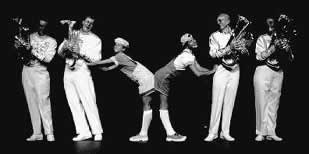 |
||
| Brass Theater offered a unique opportunity to see a performance ensemble utilize "G" bugles, as well as multi-keyed marching brass in the same environment. |
The author had a unique opportunity to witness a clinic by Brass Theater (a.k.a. Star of Indiana) in Indianapolis in 1994. The performance ensemble (a competitive drum and bugle corps only one year prior) was performing part of its program with King two-piston bugles and the remainder of the program with multi-keyed brass ("B-flat" trumpets and euphoniums; trombones, "F" mellophones and double horns, etc.).
The improvements in intonation associated with the traditionally-pitched brass instruments was dramatic and unquestionable. Whether or not performances by Brass Theater impacted DCI's decision in 1999 to allow multiple keyed brass instrumentation within the ranks of their competitive drum and bugle corps is not known. However, the legalization of trumpets and tubas and "F" mellophones for the drum corps activity was the inevitable conclusion to evolutionary advances that started with North American competition bugles the moment the piston lock was abolished in the 1940s.
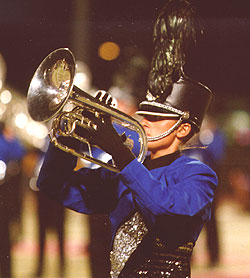 |
|
| A mellophonist with the Concord Blue Devils in 2001, along with nearly all top 12 Division I junior drum and bugle corps have embraced multiple keyed brass instrument. Photo by Ron Wollach. |
The Concord Blue Devils and the Cadets of Bergen County quickly adopted trumpets for their 2000 productions, forever changing the drum corps activity. Virtually overnight, the competition bugle industry was all but eliminated. As of 2007, three-piston "G" bugles are available through Dynasty and Kanstul Musical Instruments, but incentive programs from large manufacturers like Yamaha and King, as well as the pairing of percussion equipment and bugles by manufacturers (a tradition first observed in the 1930s), drum corps are offered tangible financial advantages in choosing "B-flat" and "F" instrumentation over three-piston bugles.
Alumni organizations and senior corps remain strong proponents of "G" bugles. Most of these organizations are acquiring instruments through online auctioning or by contacting former members who may have "secured" instruments from the corps many years prior.
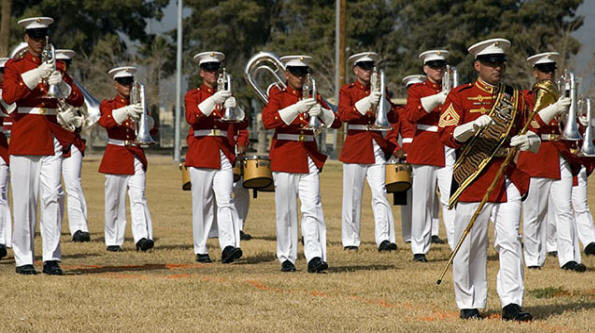 |
| The Commandant's Own Drum and Bugle Corps pictured during a February 2007 performance are utilizing recently acquired new two-piston bugles and remains one of the last organizations utilizing this technology. Photo by Linda Willets |
One organization that fervently supports traditional two-piston bugles is the Commandant's Own Drum and Bugle Corps of the United States Marine Corps. The organization recently acquired newly fabricated two-piston bugles, making the unit one of the final performing corps to utilize the two-piston bugle exclusively.
Conclusion
The creation of brass band and drum and bugle corps in North America occurred almost simultaneously. Both developed similarly, but as distinct entities during a one-hundred-and-fifty-year period beginning in the mid-nineteenth century. There are many examples from history represented in this series of articles that suggest it is a natural progression for drum and bugle corps to evolve into marching bands. As marching bands and drum corps continue to share instrument types, distinctions will continue to blue as the two activities maintain the steady course of becoming one and the same.
Special Thanks
This narrative would not have been possible were it not for the unselfish efforts of many people. Primarily, the author would like to thank bugle aficionado Jack T. Carter for his willingness to share knowledge and resources during the months it took to compile this information. Special thanks are also extended to Randy Rach for all his efforts in fact checking and providing access to his vast archive.
Others who were crucial in the compilation of this chapter include: Margaret Downey Banks of the Shrine to Music, the Belleville Black Knights Institute of Drum Corps Technology, Scott Birdsall, Michael Boo, the National Boy Scout Museum, The Boy Scouts of America, Ron DaSilva, Don Daber, Ralph T. Dudgeon, Tony Ferrero, Anthony Gero, Robert M. Hazen, Adolph Herseth, Scott Hirsch, Historic Brass Society, Zigmant Kanstul, LeBlanc Corporation, William F. Ludwig, Jr., John McCardle, Fred Mowbray, Claire Murphy Newbold, Murray State University, Paducah Community College, Paducah Public Library, Tom Peashey, Dave Peterson, Michael Petrone, Steve Powers, Harry Roach, Chris Smith, Stuart Stack, Franz X. Streitwieser, Brian Tolzmann, Transylvania University, Steve Vickers, Wallingford Public Library, Charles Wetzell, May Wooding.
Recommended Links
Tapsbugler.com -- Jari Villaneuva is a great friend of The Middle Horn Leader and utilized information from the original "Evolution of the Bugle" article in his great site.
American Civil War Bugler -- A very informative site that offers details about the day-to-day life of a bugler during the Civil War (this site is oriented toward Civil War reenactors).
The Library of Congress -- A well-researched and informative series on the brass band movement in America.
Eugene W. Berkoff -- This World War II veteran recounts an anecdote involving a Tenite Plastic Bugle issued to him during the war.
Jeff Mitchell's Bugle Web Site -- Jeff is a very knowledgeable scholar of bugle history and a brass judge for DCI.
The United States Military Academy "Hellcats" -- A tremendous resource of information and recordings of possibly the last B-flat "G-D" piston bugle ensemble anywhere.
Endnotes
(82) Zigmant Kanstul, letter to author, 20 Mar 1996.
(83) Serial Number List, Allied Supply Corporation Catalog, (Elkhorn, Wisconsin: July, 1994) 235.
(84) Tom Peashey, letter to author, 27 Nov 2995.
(85) Jodeen Popp, Competitive Drum Corps: There and Then to Here and Now, (Des Plaines, IL: Olympic Printing Company, 1979) 69.
(86) Harvey Barish, "Three Valve Bugle," Drum Corps News, September 24, 1975, p. 1.
(87) Zigmant Kanstul, letter to author, 20 Mar 1996.
(88) Popp 108.
(89) Drum Corps News, November 26, 1975, p. 13.
(90) Brian Tolzmann, "1995 Junior Corps Census Completed," Drum Corps World, Volume 24, 17:2.
(91) Dave Peterson, personal interview, 20 Feb 1996.
(92) Dr. Rosalie Sward, "Bugle, time limit and age rules defeated at Congress," Drum Corps World, Volume 16, No. 19, 1.
(93) Scooter Pirtle, "An Interview with Dynasty Bugle Corporation," The Middle Horn Leader, Volume 1, No. 4, 3.
(94) F.E. Olds, Suggested Retail Pricing List, January 1, 1973. 2.
(95) Alan Rouste, http://rouses.net/trumpet/olds.htm.
(96) Scooter Pirtle, "An Interview with Mike Dennis," The Middle Horn Leader, March, 1993. 3.
Home | Articles | Search | Enroll | Equipment | Staff | Souvies | Links | Updates
